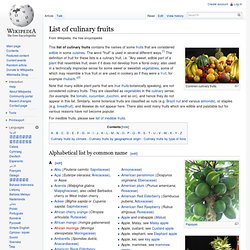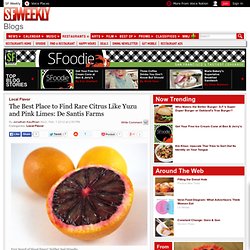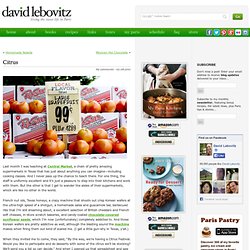

Uncommon citrus varieties (page3) Citrus Site - Full Index. Citrus Varieties in my collection. List of culinary fruits. Common culinary fruits.

This list of culinary fruits contains the names of some fruits that are considered edible in some cuisines. The word "fruit" is used in several different ways.[1] The definition of fruit for these lists is a culinary fruit, i.e. "Any sweet, edible part of a plant that resembles fruit, even if it does not develop from a floral ovary; also used in a technically imprecise sense for some sweet or sweetish vegetables, some of which may resemble a true fruit or are used in cookery as if they were a fruit, for example rhubarb.
"[2] Note that many edible plant parts that are true fruits botanically speaking, are not considered culinary fruits. For inedible fruits, please see list of inedible fruits. Alphabetical list by common name[edit] A[edit] B[edit] C[edit] Yuzu - Dwarf Citrus Trees, Meyer Lemon, Kieffer Lime, Oranges – Order Online – Four Winds Growers. RARE/SPECIALTY CITRUS TREES. DOORYARDCITRUS. The Best Place to Find Rare Citrus Like Yuzu and Pink Limes: De Santis Farms. For years, SFoodie has found it impossible to visit the Alemany Farmers' Market without gawking at Rosa de Santis's citrus stand.

Her cara caras and oro blanco grapefruit are positively mundane -- there are boxes of sweet limes and nobbly Seville oranges to paw through and smell, and up on the cash register table De Santis keeps even rarer fruits like Buddha's hand citrons and calamansi limes. We've brought home fresh bergamots to zest into a fruit crisp, and pink limes to make into a cooler. This may be the best place in the city to hit up for cocktail experimentation. De Santis, who moved to California with her family from Italy decades ago -- somewhere between Rome and Naples, she says -- has been selling citrus at San Francisco farmers' markets for 30 years; she's at both the Alemany and Civic Center markets.
The De Santises didn't set out to grow Filipino limes or or strangely shaped Chinese citrons. Member Nurseries and Fruit Sources. Nurseries Fruit Sources (Numbers refer to nurseries above) Bush 7, 17, 18Capulin 2, 6, 7, 17, 18, 20, 21, 27, 30 Cornelian 5, 7, 10, 13, 16, 18, 22, 24Nanking 6, 7, 10, 17, 18, 20, 22 Rio Grande 2, 6, 7, 11, 12, 14, 17, 20, 21, 22, 26, 27, 30, 35 Surinam 2, 6, 7, 8, 9, 10, 11, 12, 14, 17, 20, 21, 26 27, 30, 35 Chestnut 4, 5, 7, 6, 8, 9, 10, 11, 13, 15, 16, 17, 18, 22, 25, 26, 31, 33 Chinquapin 13, 14, 15Cinnamon 2, 7, 11, 13, 14, 17, 18, 20, 6, 30 Citrus 1, 2, 3, 6, 7, 9, 10, 11, 12, 13, 15, 17, 18, 20, 21, 22, 27, 30, 31, 33, 38.

Citrus. Last month I was teaching at Central Market, a chain of pretty amazing supermarkets in Texas that has just about anything you can imagine—including cooking classes.

And I never pass up the chance to teach there. For one thing, the staff is uniformly excellent and it’s just a pleasure to step into their kitchens and work with them. But the other is that I get to wander the aisles of their supermarkets, which are like no other in the world. French nut oils, Texas honeys, a crazy machine that shoots out crisp Korean wafers at the ultra-high speed of a shotgun, a homemade salsa and guacamole bar, barbecued ribs that I’m still dreaming about, a excellent selection of British cheddars and French soft cheeses, in-store scratch bakeries, and candy-coated chocolate-covered sunflower seeds, which I’m now (unfortunately) completely addicted to.
And those Korean wafers are pretty addictive as well, although the blasting sound the machine makes when firing them out kind of scared me. Citrus Recipes.